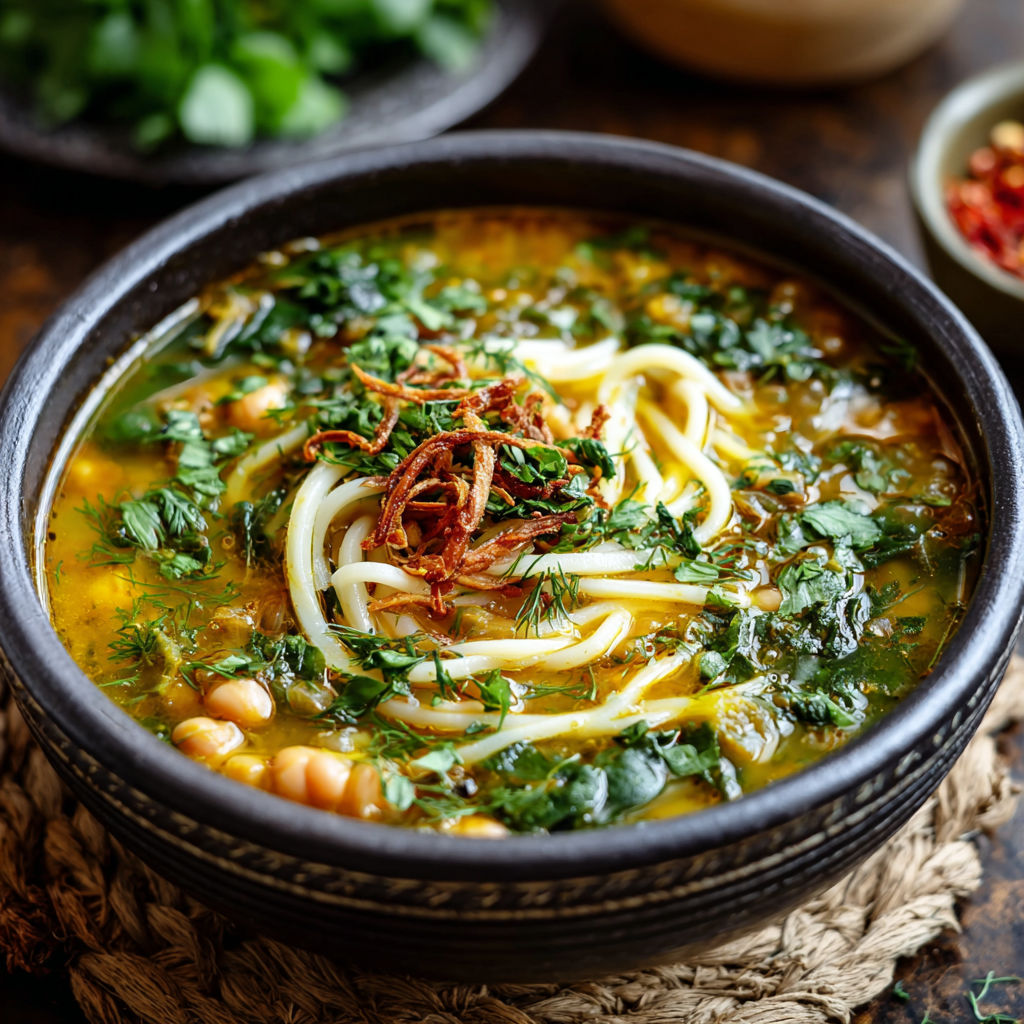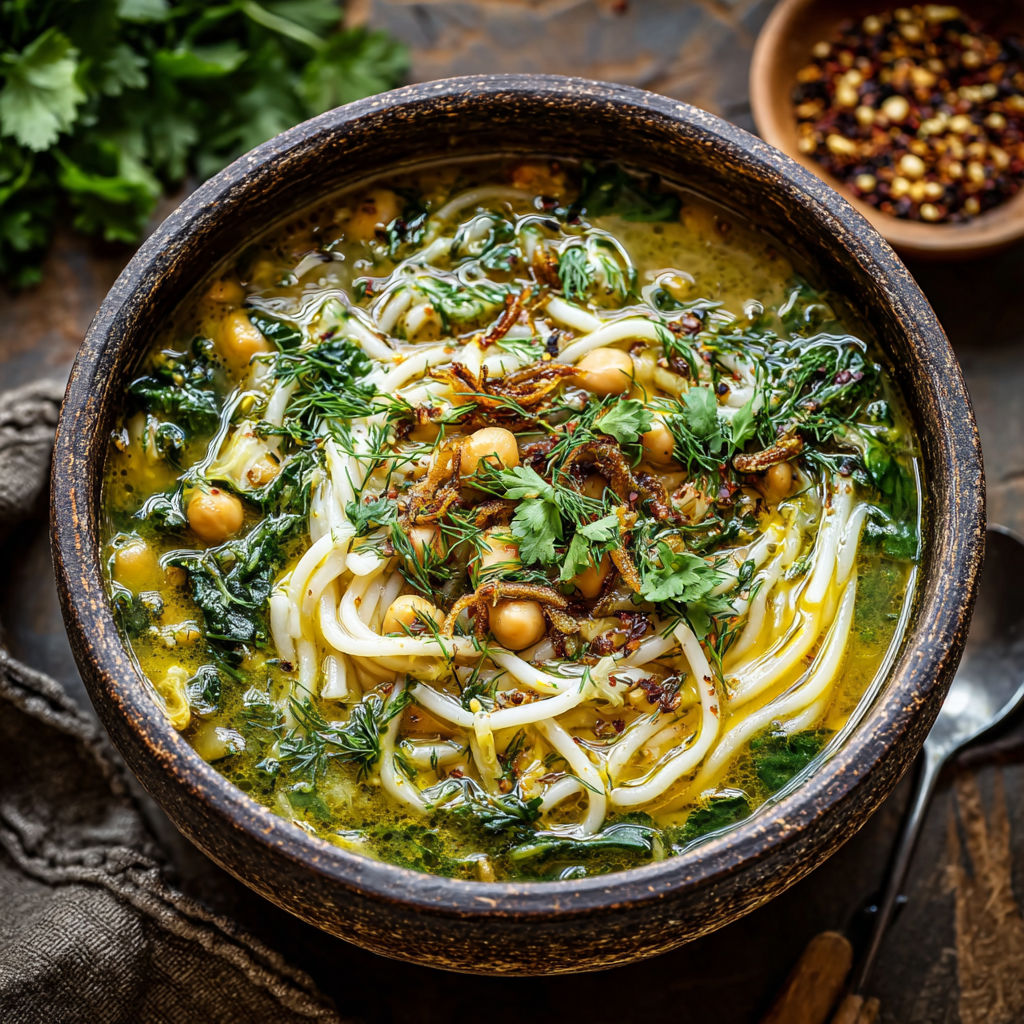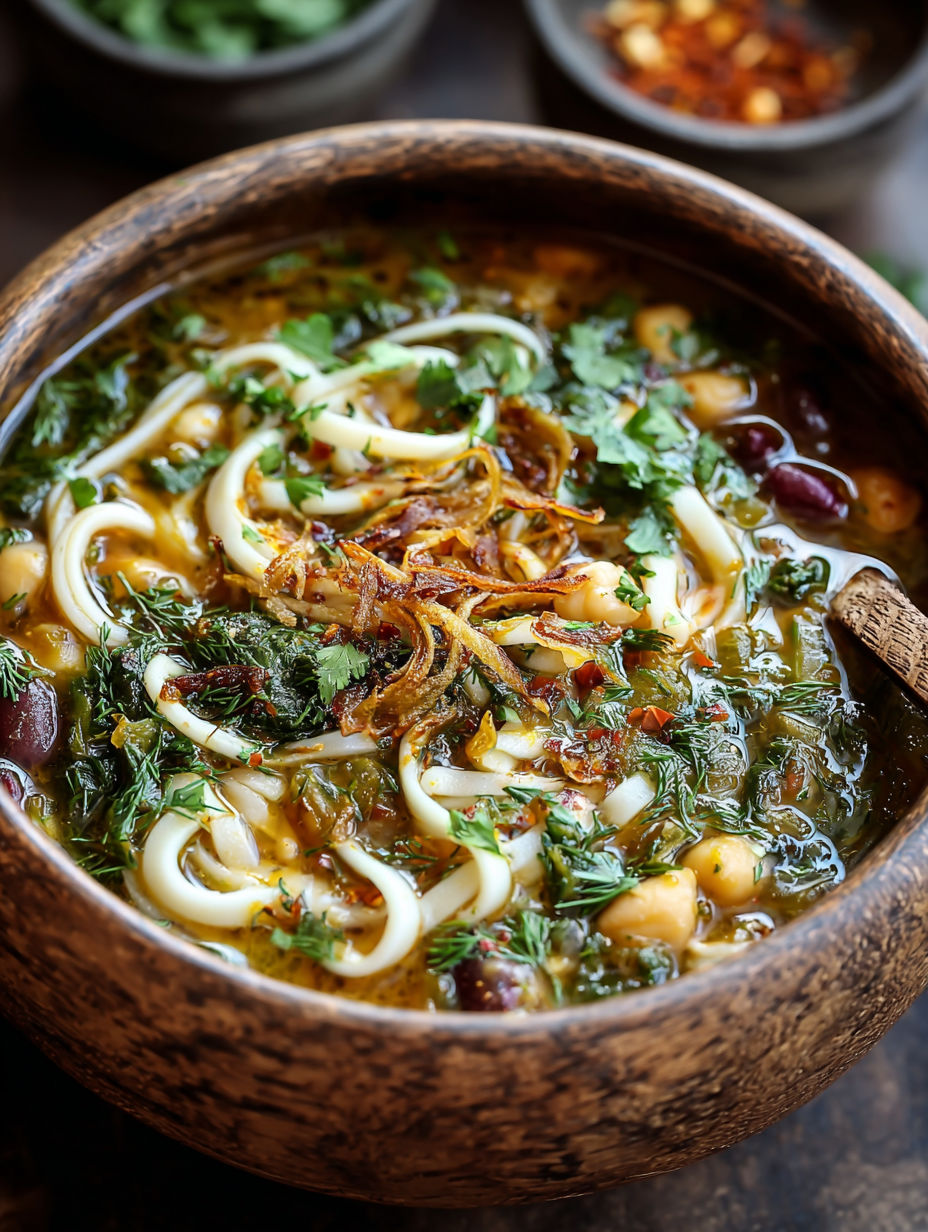 Pin
Pin
This Persian noodle soup, known as Ash Reshteh, brings together hearty legumes, tender noodles, and fresh herbs in a way that warms both body and soul. Each spoonful delivers a perfect balance of earthy legumes, bright herbs, and comforting noodles that has made this dish a staple in Persian cuisine for centuries.
I first tasted this soup at a Persian friend's home during winter, and I was immediately captivated by how something so nourishing could also be so complex in flavor. Since then, it's become my go-to recipe whenever I want to impress guests with something that feels both exotic and comforting.
Ingredients
- Olive oil creates the foundation for building flavor at the start
- Yellow onion adds sweetness when properly caramelized
- Fresh garlic provides essential aromatic notes
- Turmeric brings color and earthy warmth
- Vegetable broth enhances the soup without overpowering the herbs
- Lentils cook quickly and add protein without pre-soaking
- Chickpeas provide a hearty texture and nutty flavor
- Navy beans add creaminess when they begin to break down
- Kidney beans contribute a meaty texture and rich color
- Persian noodles or linguine give the soup its signature texture
- Fresh spinach wilts beautifully and adds nutrition
- Cilantro brings brightness and traditional Persian flavor
- Parsley provides a clean peppery note
- Fresh dill adds distinctive aroma that defines this soup
- Sour cream or yogurt creates a tangy contrast when served
- Fried onions for garnish add a crucial crunchy texture element
How To Make Persian Noodle Soup
- Sauté the Base
- Heat the olive oil in a large heavy-bottomed pot over medium heat until it shimmers. Add the diced onion and cook for about 5 minutes until they become translucent and start to turn golden at the edges. Stir occasionally to prevent burning and promote even cooking.
- Bloom the Aromatics
- Add the minced garlic and turmeric to the softened onions and stir constantly for 1-2 minutes. The turmeric will become intensely fragrant and the garlic should soften but not brown. This step awakens the essential oils in both ingredients.
- Build the Broth
- Pour in the vegetable broth and add all the legumes including lentils, chickpeas, navy beans, and kidney beans. Bring the mixture to a gentle boil, then reduce the heat to maintain a simmer. Cook uncovered for 20 minutes to allow the lentils to soften and the flavors to meld.
- Cook the Noodles
- Add the Persian noodles or linguine directly to the simmering soup. Stir gently to prevent clumping and ensure the noodles are fully submerged. Cook for 10 minutes or until the noodles are tender but still have a slight bite to them.
- Incorporate the Greens
- Add all the chopped herbs and spinach to the pot. Gently fold them into the hot soup until they begin to wilt. Allow the mixture to simmer for another 5-7 minutes until the greens have fully softened and released their flavors into the broth.
- Season and Serve
- Taste the soup and adjust the seasoning with salt and pepper as needed. Ladle the hot soup into warmed bowls. Top each serving with a generous dollop of sour cream or yogurt and a sprinkle of crispy fried onions.
The fresh dill is truly the secret hero of this recipe. I once made it without dill when I couldn't find any at the market, and while still good, it missed that distinctive Persian character. My Persian neighbor later told me that in her family, they judge the quality of Ash Reshteh by the generosity of the dill used.
Making Ahead and Storage
Persian noodle soup actually improves with time as the flavors meld together. You can prepare this soup up to three days ahead and store it in the refrigerator. The noodles will continue to absorb liquid, so when reheating, you may need to add additional broth to achieve your desired consistency. For longer storage, freeze portions in airtight containers for up to three months, though I recommend freezing before adding the noodles and herbs, then adding fresh ones when reheating.
Adaptations and Substitutions
While traditional Persian Ash Reshteh uses specific ingredients, this soup welcomes adaptations based on what you have available. If you cannot find Persian noodles, regular linguine or fettuccine broken into shorter lengths works well. The bean varieties can be flexible too. No kidney beans? Double up on navy beans. Short on fresh herbs? Use half the amount of dried herbs instead, adding them earlier in the cooking process. For a meat version, brown ground lamb or beef with the onions at the beginning.

Traditional Serving Suggestions
In Persian households, this soup is typically served with several accompaniments that enhance its flavors. Crispy fried onions are not just a garnish but an essential component that adds textural contrast. The tangy yogurt or sour cream topping provides creamy richness that balances the earthy legumes. Serve with warm flatbread like lavash or sangak for dipping. Many Persian families also serve this with a small plate of fresh herbs, radishes, and feta cheese on the side, allowing diners to customize each spoonful with additional fresh elements.

Recipe FAQs
- → Can I use different beans in this Persian noodle soup?
Yes, you can substitute any of the beans with what you have available. Black beans, pinto beans, or cannellini beans work well. The key is maintaining a variety of legumes for texture and nutritional diversity.
- → What can I substitute for Persian noodles?
Linguine is already mentioned as an alternative, but you could also use fettuccine, angel hair pasta, or even broken spaghetti. For a gluten-free option, rice noodles or quinoa can work too, though cooking times will vary.
- → How do I make fried onions for garnish?
Thinly slice an onion and heat 1/4 cup oil in a pan over medium-high heat. Add the onions and fry until golden brown (about 5-7 minutes), stirring occasionally. Remove with a slotted spoon and drain on paper towels. Season with a pinch of salt while still hot.
- → Can this soup be made ahead of time?
Yes, this soup actually improves with time as flavors meld. Make it a day ahead but add the noodles and fresh herbs only when reheating to serve. The base with beans and lentils can be refrigerated for up to 3 days or frozen for up to 3 months.
- → Is there a way to make this soup creamier?
For a creamier version, blend 1 cup of the cooked beans with some broth and return to the pot. Alternatively, increase the amount of yogurt stirred in just before serving, or add a splash of coconut milk for richness with a slightly different flavor profile.
- → What herbs can I substitute if I don't have all three (cilantro, parsley, dill)?
You can emphasize any of the three herbs if you're missing others. Mint makes a good substitute for dill, while basil can work in place of cilantro. The key is using fresh herbs—dried herbs won't provide the same brightness but can be used in smaller quantities if necessary.
